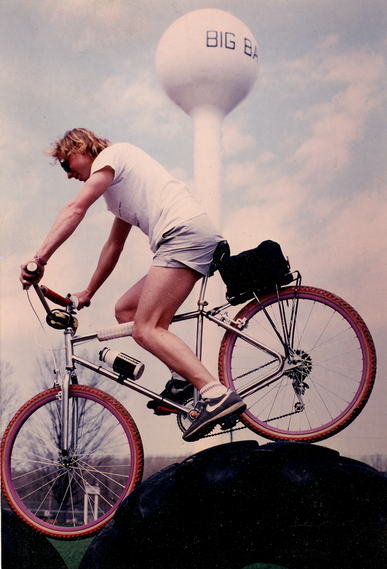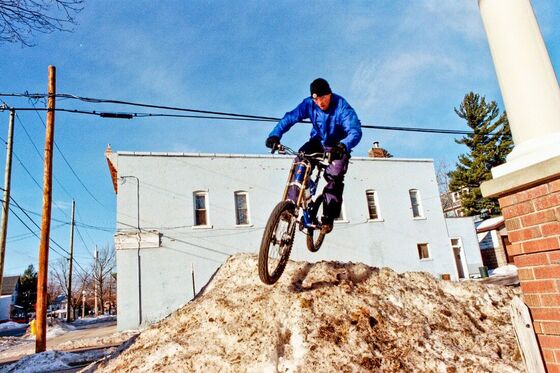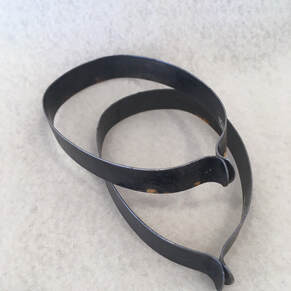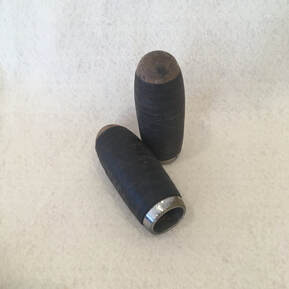The Great Outdoors: The History of Recreation in Marquette County Special Exhibit
|
Bicycling | Birding | Cross Country Skiing | Dog Sled | Downhill Skiing | Guts Frisbee | Ice Skating | Luge | Paddling | Rock & Ice Climbing | Running | Scuba Diving | Ski Jumping | Snowshoe | Trails | Wildlife Photography
|
While a few brave people rode the penny farthings or boneshakers with a large front wheel, the modern safety bicycle of the 1890s was the bicycle that really started the trend. The safety bicycle was developed with pneumatic tires and the diamond frame. Safety bicycles were available in many local stores, including a local music shop. Merchants were eager to sell the machines and men, women and children all wanted one. One just needed $100 to buy one.
 The Marquette and Ishpeming clubs meeting in downtown Ishpeming, 1888.
The Marquette and Ishpeming clubs meeting in downtown Ishpeming, 1888.
Riding conditions were difficult at the time: roads were usually dirt, some had crushed rock, a few were paved or “macadamized.” Around town, one usually encountered one or more hills. Bicyclists rode illegally on the wooden sidewalks but one could be fined or even jailed for speeding. Livestock could also be an obstacle.
One woman recalled taking advantage of the train: “We go to Negaunee by rail and ride our bicycles back, because it is downhill most of the way.” She also rode the train to Ishpeming and bicycled on Cliffs Drive (where Suicide Hill ski jump is today).
A group ride around town led to the formation of Marquette’s bicycle club: Kitchi-mi-Kana, Ojibwe for “good roads” in 1895. The club held a parade of 168 riders, including sixty women. The club went on group rides and hosted events for other area clubs. The club also competed in races on holidays. They worked to get good riding roads, including a narrow path of compact clay to ride out to Presque Isle. The city paid for part and the club donated $550 toward the path.
One woman recalled taking advantage of the train: “We go to Negaunee by rail and ride our bicycles back, because it is downhill most of the way.” She also rode the train to Ishpeming and bicycled on Cliffs Drive (where Suicide Hill ski jump is today).
A group ride around town led to the formation of Marquette’s bicycle club: Kitchi-mi-Kana, Ojibwe for “good roads” in 1895. The club held a parade of 168 riders, including sixty women. The club went on group rides and hosted events for other area clubs. The club also competed in races on holidays. They worked to get good riding roads, including a narrow path of compact clay to ride out to Presque Isle. The city paid for part and the club donated $550 toward the path.
In the 1950s and 60s bicycling was more a kid’s hobby. Holly Greer worked to get the bike path built out to Presque Isle Park for families to have a safe place to ride. On a car ride out to Presque Isle with her son, she almost hit a child on a bicycle. She immediately went to her friends, and they gathered 1,500 names on a petition for the city commission to build the bike path. The original path, which extended only from Fair Avenue to Presque Isle along Lakeshore Boulevard, was begun in 1971. Holly later served as Marquette’s first female mayor and the bike path was named after her. Since then, the city bike trails have expanded west and south to Harvey, connecting to the Iron Ore Heritage Trail, the North Country Trail and others.
With a growth in paved and single track trails, Marquette area biking has grown in the last 20 years. Single track is a type of mountain biking which uses a trail only as wide as the bike, instead of a two-track or dirt road.
With a growth in paved and single track trails, Marquette area biking has grown in the last 20 years. Single track is a type of mountain biking which uses a trail only as wide as the bike, instead of a two-track or dirt road.
Mountain biking became popular nationally in the 1990s, but Marquette’s mountain biking goes back to the 1980s. Local bike pioneers built bikes for dirt roads, paths, and even the snow.
The Ore to Shore Bike Race has run in August since 2000. The 48 mile or 28 mile course starts in Ishpeming or Negaunee and finishes almost 1000’ lower near Lake Superior.
Greg Potvin recalls ordering parts and building bicycles with a cruiser frame and fat tires in the 1980s. He and his friends rode on the beach, in the winter, took day trips to Big Bay, or even took 3-4 day rides up to the Keewenaw, mainly on dirt roads. Most serious bicyclists and athletes were riding road bikes known as “10 speeds,” and people didn’t understand what or why they were riding out in the woods. Mountain biking was just developing at the time. They called their bikes cruisers.
The Ore to Shore Bike Race has run in August since 2000. The 48 mile or 28 mile course starts in Ishpeming or Negaunee and finishes almost 1000’ lower near Lake Superior.
Greg Potvin recalls ordering parts and building bicycles with a cruiser frame and fat tires in the 1980s. He and his friends rode on the beach, in the winter, took day trips to Big Bay, or even took 3-4 day rides up to the Keewenaw, mainly on dirt roads. Most serious bicyclists and athletes were riding road bikes known as “10 speeds,” and people didn’t understand what or why they were riding out in the woods. Mountain biking was just developing at the time. They called their bikes cruisers.
Quick Stop Bike Shop is the oldest bike shop in town. Don Potvin opened the business circa 1974. It was a place for kids and young adults to learn how to repair and build bicycles. The original shop was in the livery stable behind today’s store.
In 1983 Greg partnered with Don Snitgen and Pam Dalitz to open what is thought to be Marquette’s first bike touring company. The day trips and overnight tours used bicycles assembled especially for the tours. Trips to area waterfalls or Big Bay were featured.
In 1983 Greg partnered with Don Snitgen and Pam Dalitz to open what is thought to be Marquette’s first bike touring company. The day trips and overnight tours used bicycles assembled especially for the tours. Trips to area waterfalls or Big Bay were featured.
The above photographs are courtesy of Greg Potvin.
Marquette’s first BMX track was built around 1980 at the end of Baraga St. (near the present day Salvation Army). Minx Sport Shop (located on Third St.) owners Bruce “Buzz” Tiseo and Dominic Loghini helped start the track and formed the first BMX team, “Team Minx.” The present track is located at the Kaufman Sports Complex on Hawley Street.
Mechanics at Minx included Andy Gregg and Sten Fjeldheim. BMX racers could purchase bikes at the shop or order frames to custom build their bikes.
Mechanics at Minx included Andy Gregg and Sten Fjeldheim. BMX racers could purchase bikes at the shop or order frames to custom build their bikes.
Left to right on the gate at the BMX track circa 1981: Matt Marenger (currently the owner of Mr. Bike in Escanaba), Frank Bink, John Duflo,
Jim Mercure, and Ron Young. Photo by Andy Gregg/BikeFurniture.com
Jim Mercure, and Ron Young. Photo by Andy Gregg/BikeFurniture.com
Mike Brunet jumping a snowbank at the corner of Michigan and High Streets 2003, photo courtesy Andy Gregg/BikeFurniture.com.
Mike has been involved in building the Noquemanon Trails and has served on its board since 2006.
Mike has been involved in building the Noquemanon Trails and has served on its board since 2006.
Images from the museum gallery
Matt Calcaterra moved to Marquette to attend NMU. Since the mountain bike wasn’t yet commercially available, he and a few other Northern students built bikes like these from spare parts with a cruiser frame. Note the mis-matched tires. Matt recalls driving around town with a wrench to take parts off free bicycles he found. He and his friends rode their bikes on walking trails in south Marquette. Later Matt opened LakeShore Bike.
Bicycle Lanterns ran on kerosene (1876--right) and acetylene gas (left) produced from calcium carbide and water.
The Solar (left) was first made by the American Badger Brass Co. in Kenosha, Wisconsin in 1897. Lights had red and green jewels like boat lanterns to represent left and right. Electric lights were first made in 1888, but were not common until the 1930s.
Clamps for holding pant legs out of the bicycle’s gears, circa 1900 and wooden bicycle handle grips.
Thank you to all who contributed photographs to be used in this exhibit. Historic photographs are from the J.M. Longyear Research Library at the MRHC.














